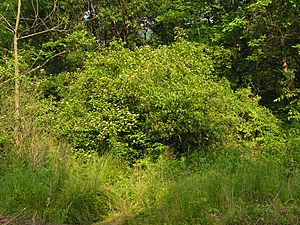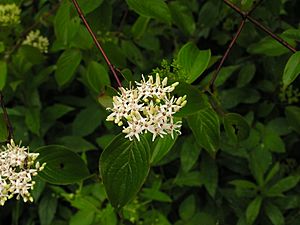Silky dogwood facts for kids
Quick facts for kids Silky dogwood |
|
|---|---|
 |
|
| Scientific classification | |
| Genus: |
Cornus
|
| Species: |
amomum
|
The Cornus amomum, also known as the silky dogwood, is a type of dogwood tree. It grows naturally in the eastern United States. You can find it from Michigan and Vermont all the way south to Alabama and Florida. People sometimes call this dogwood by other names like red willow, silky cornel, kinnikinnick, or squawbush.
Contents
About the Silky Dogwood
The silky dogwood is a deciduous shrub. This means it's a bushy plant that loses its leaves every autumn. It can grow up to 5 meters (about 16 feet) tall. Its leaves grow opposite each other on the stem. They are about 10 centimeters (4 inches) long and 7 centimeters (2.75 inches) wide. The leaves are oval-shaped with a pointed tip.
The plant produces its flowers in clusters called cymes. These flowers are yellowish-white and have four petals. They usually bloom between May and June. After the flowers, small blue fruits appear. These fruits are called drupes, which means they have a hard pit inside, like a cherry. The leaves of the silky dogwood are often rusty brown and feel a bit fuzzy. They usually have 4 to 5 veins on each side. If left alone, this plant can grow into thick, dense areas.
Naming the Silky Dogwood
Scientists often place the silky dogwood in the Cornus group. Its full scientific name is Cornus amomum Mill.. Sometimes, it's put in a different group called Swida as Swida amomum (Mill.) Small. Another similar plant, Cornus obliqua, used to be considered a part of Cornus amomum. However, scientists now see it as its own separate species.
What its name means
The name Cornus comes from a Latin word meaning "horn." This describes how hard the wood of dogwood trees is. The word Amomum also comes from Latin and means "eastern spice."
Where it Grows
The silky dogwood is a plant that naturally lives in eastern North America. It loves wet places like swamps, marshes, and bogs. You can also find it west of the Mississippi River, reaching into eastern Kansas, Nebraska, and parts of northern Oklahoma. While Cornus amomum is only found in the U.S., other similar species like Cornus obliqua can be found in Canada.
This plant prefers a bit of shade but can also grow in full sunlight. If you plant it, adding organic materials helps keep the soil wet, which the shrub loves. Silky dogwood often grows near creeks or other water systems. It can be found in many states, including West Virginia, Virginia, Vermont, South Carolina, Maine, Kentucky, Iowa, Indiana, Illinois, Georgia, Florida, Delaware, Connecticut, Alabama, Maryland, Massachusetts, Michigan, Mississippi, Missouri, New Hampshire, New Jersey, New York, North Carolina, Ohio, Pennsylvania, and Rhode Island. It grows from sea level up to about 1,500 feet high.
Is it in Danger?
According to the IUCN Red List, which checks how safe plants and animals are, the silky dogwood is a "Least Concern" plant. This means it's not currently in danger of disappearing across most of eastern North America. However, in the state of Indiana, the silky dogwood is considered an endangered plant.
Who Uses it?
Many animals enjoy the fruits of the silky dogwood. Songbirds, insects, and small animals like rodents eat its berries, which grow in the summer. Larger animals such as White-tailed deer and elk also feast on the fruit. When animals eat the fruit, they help spread the plant's seeds to new places. Sometimes, animals only pick the ripe fruits and seeds, which can accidentally damage good seeds that would otherwise grow.
What it's Good For
Dogwood plants are popular for decorating yards and gardens across the United States. Gardeners like them for their pretty spring flowers, green summer leaves, colorful fruits, and autumn leaf colors. Each type of dogwood looks unique. The silky dogwood is a shrub that works well in areas where water collects or runs off a lot, as it loves moist to wet soil. It adds beautiful colors to landscapes in spring, summer, and fall.
People also use silky dogwood outdoors to help stop soil from washing away on slopes. Farmers and landowners can plant it to create windbreaks around homes and fields. It can also be used to make natural borders between land areas and to help protect wildlife. When planted with other strong-rooted trees and shrubs like willows, it can help stop stream banks from eroding and make them more stable.
There aren't many big problems with using silky dogwood as a natural border. Sometimes, grazing animals like deer or livestock might damage the shrub when the fruit is ripe. Other than that, there are no major diseases or pests that cause problems for the silky dogwood.
Images for kids




